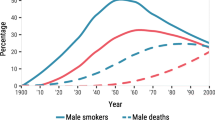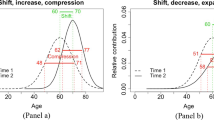Abstract
This paper examined whether international variations in absolute and relative gender differences in mortality are related to the overall mortality rates, and whether the international variation in gender gap in mortality can in part be explained by smoking. I used data on mortality from all causes in 32 European countries published by the World Health Organisation, and indirect estimates of mortality attributable to smoking in the age band 35–69 years by Peto et al. The main analyses were restricted to the age band 35–69 years but results for mortality at all ages were virtually identical. The overall mortality rates (both sexes combined) were strongly related to absolute gender differences (r = 0.91) but only weakly to relative differences (r = 0.35). The gender gap was larger in eastern than in western Europe for rate differences (1005 vs. 530 per 100,000, respectively), but it was similar for rate ratios (2.3 vs. 2.1, respectively). Both absolute and relative gender differences in mortality were strongly related to the difference between men and women in the proportion of all deaths attributed to tobacco (partial correlations, after controlling for the overall death rates, were 0.59 and 0.66, respectively). Excluding tobacco-related deaths attenuated the associations between the overall mortality rates with absolute differences (r = 0.70) and reduced the difference in the absolute gender gap between eastern and western Europe. More importantly, excluding tobacco-related deaths eliminated entirely the association with relative differences (r = −0.15) as well as any suggestion that the relative gender gap is larger in eastern than in western Europe. These results show that tobacco plays an important role in generating international differences in the size of gender gap in mortality. The much discussed association between the overall life expectancy and the gender gap in life expectancy is a numerical product of absolute death rates (differences in life expectancy are driven by differences in rates). The association of overall mortality with male/female mortality ratios is much weaker.
Similar content being viewed by others
References
Lopez AD. The sex mortality differential in developed countries. In: Lopez AD, Ruzicka LT (eds), Sex Differentials in Mortality. Trends, Determinants and Consequences. Canberra: Department of Demography, Australian National University, 1983; 53–120.
Waldron I. Recent trends in sex mortalityratios for adults in developed countries. Soc Sci Med 1993; 36(4): 451–462.
Nikiforov SV, Mamaev VB. The development of sex differences in cardiovascular disease mortality: A historical perspective. Am J Public Health 1998; 88: 1348–1353.
Barrett-Connor E. Sex differences in coronaryheart disease: Why are women so superior? The 1995 Ancel Keys Lecture. Circulation 1997; 95: 252–264.
Bobak M, Marmot M. East-west health divide and potential explanations. In: Hertzman C, Kelly S, Bobak M (eds), East-West Life Expectancy Gap in Europe. Environmental and Non-environmental Determinants. Dordrecht: Kluwer Academic Publishers, 1996; 17–44.
Bobak M, Marmot M. East-west mortality divide and its potential explanations: proposed research agenda. Br Med J 1996; 312: 421–425.
Waldron I. Sex differences in human mortality: The role of genetic factors. Soc Sci Med 1983; 17(6): 321–333.
Watson P. Explaining rising mortality among men in Eastern Europe. Soc Sci Med 1995; 41: 923–934.
Peto R, Lopez AD, Boreham J, Thun M, Heath C Jr. Mortality from tobacco in developed countries: Indirect estimation from national vital statistics. Lancet 1992; 339: 1268–1278.
Peto R, Lopez AD, Boreham J, Thun M, Heath C Jr. Mortality From Smoking in Developed Countries 1950-2000: Indirect Estimates from National Vital Statistics. Oxford: Oxford UniversityPress, 1994.
Kleinbaum DG, Kupper LL, Morgenstern H. Epidemiologic Research. Principles and Quantitative Methods. New York: Van Nostrand Reinhold, 1982.
Sterling TD, Rosenbaum WL, Weinkam JJ. Tobacco associated deaths. Lancet 1992; 340: 666–668.
Sterling TD, Rosenbaum WL, Weinkam JJ. Risk attribution and tobacco-related deaths. Am J Epidemiol 1993; 138: 128–139.
Jackson R, Chambless L, Higgins M, Kuulasmaa K, Wijnberg L, Williams D. Gender differences in ischaemic heart disease mortality and risk factors in 46 communities: An ecologic analysis. Cardiovasc Risk Factors 1997; 7: 43–54.
Waldron I. The contribution of smoking to sex differences in mortality. Public Health Rep 1986; 101(2): 163–173.
Valkonen T, van Poppel F. The contribution of smoking to sex differences in life expectancy. Four Nordic countries and the Netherlands 1970-1989. Eur J Public Health 1997; 7: 302–310.
Larsson B, Bengtsson C, Bjorntorp P, et al. Is abdominal bodyfat distribution a major explanation for the sex difference in the incidence of myocardial infarcion? Am J Epidemiol 1992; 135: 266–273.
Author information
Authors and Affiliations
Rights and permissions
About this article
Cite this article
Bobak, M. Relative and absolute gender gap in all-cause mortality in Europe and the contribution of smoking. Eur J Epidemiol 18, 15–18 (2003). https://doi.org/10.1023/A:1022556718939
Issue Date:
DOI: https://doi.org/10.1023/A:1022556718939




